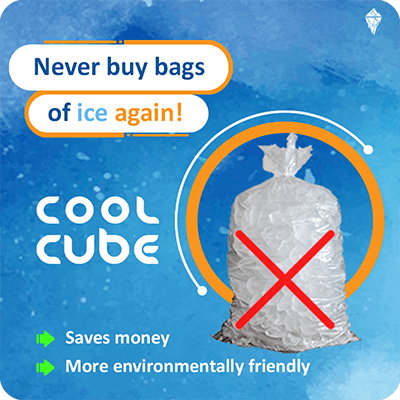
Powerful Coolers
No more ice needed
Easy installment
Any bath/tub/pool will work
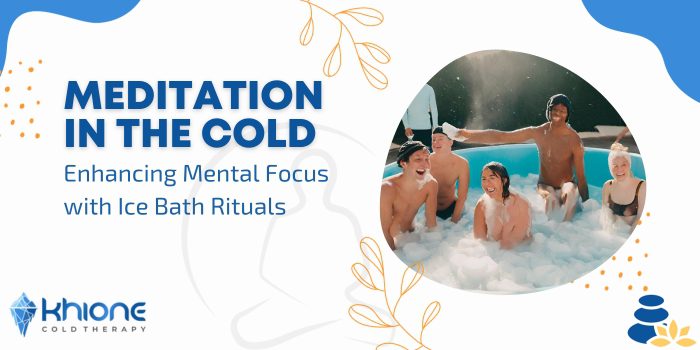

The blend of meditation and cold immersion may seem counterintuitive at first. While meditation often brings forth images of warm, comfortable environments, cold exposure paints a picture of discomfort and challenge. Yet, when the serene practice of meditation meets the exhilarating experience of cold immersion, the result is a transformative mental journey. Let’s delve into the synergy of these two practices and how they can deepen our mindfulness, resilience, and focus.
The Essence of Meditation
Meditation, at its core, is a practice of anchoring the mind, whether it’s to a breath, a mantra, or simply the present moment. By training our minds to remain centred despite external or internal distractions, we cultivate a state of peace, clarity, and heightened awareness.
Cold Immersion: The Ultimate Mindfulness Test
Enter cold immersion, a true test of mindfulness. When our body confronts the shock of icy water, the immediate instinct is to flee or fight. However, staying present in this discomfort forces us to transcend our primal reactions and ground ourselves in the present.
The Symbiotic Relationship
- Heightened Presence: The sheer intensity of cold immersion ensures that you’re wholly present. The mind doesn’t wander; it’s entirely in the now, amplifying the essence of meditation.
- Deepened Breathing: As anyone familiar with the Wim Hof method knows, cold exposure can stimulate profound, rhythmic breathing. This natural response aligns seamlessly with meditation practices that emphasize breath awareness.
- Mental Resilience: Continuously confronting and accepting the discomfort of cold cultivates a mental strength that is transferable to other challenges in life.
- Sensory Awareness: The cold amplifies bodily sensations, making us acutely aware of our physical presence, aiding in body scan meditation techniques.
Incorporating Ice Bath Rituals in Meditation
Utilizing ice bath chilling machines can significantly enhance this combined experience:
- Consistency is Key: The machine ensures a consistent temperature, allowing you to focus solely on your meditative practice without the distraction of fluctuating cold levels.
- Safety First: Being able to control the duration and temperature means you can safely push your boundaries without risk.
- Setting the Stage: Pair your ice bath ritual with calming music, essential oils, or guided meditations to enrich the experience.
Meditation Post-Cold Immersion
For those not ready to meditate during the cold immersion, meditating immediately after provides its unique set of benefits. The post-immersion rush of endorphins, combined with the body’s natural relaxation response, can pave the way for an incredibly profound meditative session.
Conclusion
While both meditation and cold immersion are powerful on their own, their combination can lead to a synergistic enhancement of mental clarity, focus, and resilience. It’s a journey of diving deep, both literally and metaphorically, into the realms of the mind and body. If you’re seeking a heightened meditative experience, consider incorporating the chill – it might just be the breakthrough you need.
The Real Trend in Pro Cycling: Ice Baths for Ultimate Recovery — Why Adam Yates and Possibly You Should Consider the CoolTub and CoolCube
September 13, 2023
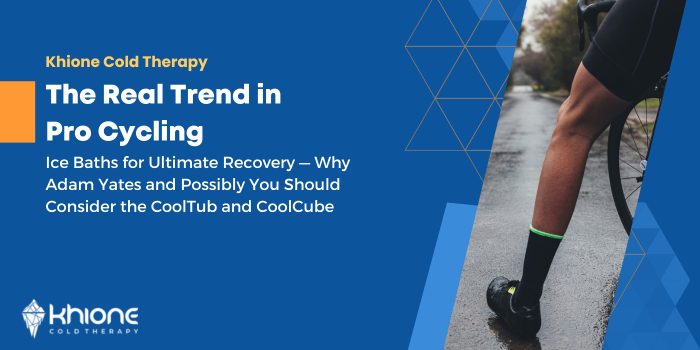

In the exciting world of professional cycling, where every second counts, athletes are perpetually looking for that extra edge in performance and recovery. We witnessed something utterly fascinating recently at the Tour de France, which may not be as flashy as a sprint finish but could be just as impactful in the grand scheme of a race.
Ice, Ice, Baby: Yates Takes a Cool Dip
Imagine this. You’re among the group of journalists and fans, eagerly waiting near the team buses after a grueling stage of the Tour de France that finishes atop La Super Planche des Belles Filles. Among the riders, Tadej Pogačar has just won the stage, but it’s not him who captures your attention. It’s Adam Yates of the Ineos Grenadiers who’s making headlines—but not for crossing the finish line first. Instead, he’s caught everyone’s eyes for a different reason. He’s taking an ice bath.
After coming ninth in stage seven, losing 29 seconds plus a 10-second bonus to the race leader, Yates didn’t head for the usual shower on the bus or hop onto a turbo trainer for a warm-down like his teammate Geraint Thomas. No, he opted for a cold bath. On a scorching day in eastern France, with temperatures soaring over 24 degrees Celsius, the decision seemed both unexpected and absolutely brilliant.
The Why and How of Yates’ Chill-Out Session
Yates has a history of struggling in extreme heat. Remember the 2018 Tour de France? The heat played a role in him losing valuable time. This year, he’s leaving no stone unturned, which includes prioritizing immediate cooling post-stage.
New marginal gain? Ice bath post-race for Adam Yates. #TDF2022 pic.twitter.com/r3RfIxYpDy
— Sophie Smith (@SophieSmith86) July 8, 2022
Rod Ellingworth, Ineos’ deputy team principal, clarified: “He always tries to cool himself down as soon as he can, so he does a pretty good job with it. It’s one of the logistical challenges of trying to move these things around.”
Enter the CoolTub and CoolCube: The Future of Ice Bathing in Cycling
While what Yates used might be a bit more rudimentary, imagine if he had access to something even better? This brings us to our star products, the CoolTub and CoolCube. Unlike inflatable baths that are more like paddling pools, the CoolTub offers a luxurious yet practical ice bath experience. And it isn’t just for professional cyclists; anyone aiming for better physical recovery can use it.
Even better? The CoolCube ensures that the water remains at your desired temperature, maintaining optimal conditions for muscle recovery, making it an indispensable companion to the CoolTub.
The Uptrend of Ice Baths in Professional Cycling
Yates is no anomaly; he’s part of a growing trend. More and more professional cyclists are turning to ice baths for recovery. And why wouldn’t they? The benefits range from immediate cooling, as in the case of Yates, to quicker muscle recovery and less soreness, all of which can be critical in a long, demanding race like the Tour de France.
If you want to optimize your training and recovery regimen like a pro, you need to seriously consider integrating ice baths into your routine. And what better way to do that than with the CoolTub and CoolCube?
So, whether you’re a professional cyclist or someone who’s just passionate about fitness, if immediate cooling and muscle recovery sound good to you, it’s high time you take the plunge — quite literally!
Happy cooling! 🚴♂️❄️
How to Incorporate Ice Baths into Your Wellness Routine
September 7, 2023
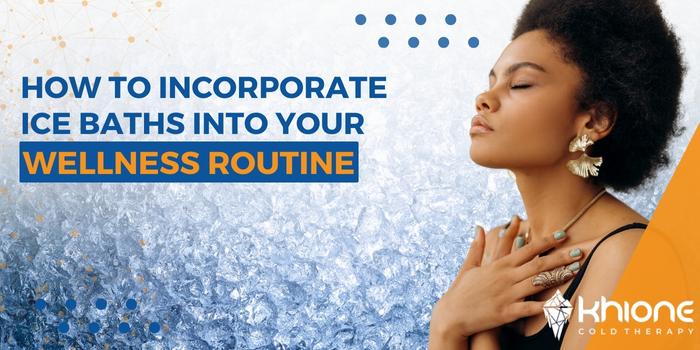

Introduction
The concept of cold therapy has been around for centuries, with roots in various cultures and a multitude of documented health benefits. However, the modern wellness industry is seeing a resurgence of interest in ice baths, thanks in part to cutting-edge technology and research. As the experts in cold therapy, we at Khione have developed an array of equipment designed to elevate your ice bath experience. So, how do you go about incorporating this ancient-yet-innovative practice into your wellness routine? Read on to find out!
Start with the Basics: Know the Benefits
Before diving into the icy water, it’s crucial to understand the potential benefits that come with it:
- Faster muscle recovery
- Improved circulation
- Reduced inflammation
- Enhanced mental clarity
- Elevated mood
- Boosted metabolism
Determine Your Goals
Knowing why you’re taking the plunge can guide how you incorporate ice baths into your routine. Are you an athlete focused on muscle recovery? A busy professional looking to de-stress? Tailoring your ice bath experience to your specific needs will help you achieve optimal results.
Finding the Right Equipment
From portable ice baths to luxurious home installations, there are options for everyone. Khione offers an array of choices designed to suit various lifestyles and budgets. Evaluate your space, frequency of use, and other preferences to make an informed decision.
Timing is Everything
It’s crucial to find the optimal time to incorporate ice baths into your routine. Here are some guidelines:
- For Athletes: Post-workout is usually best for muscle recovery.
- For Stress-Relief: Anytime is fine, though many prefer evening baths to unwind before bed.
- For Mental Clarity: Morning ice baths can jump-start your day.
Temperature and Duration: Find Your Sweet Spot
The temperature for an ice bath typically ranges between 50-59°F (3-12°C). The duration can vary between 3-20 minutes, depending on your comfort level and objectives. Beginners should start with shorter durations and work their way up.
Safety First
While ice baths offer a plethora of benefits, they’re not suitable for everyone. People with heart conditions, Raynaud’s disease, or those who are pregnant should consult a healthcare provider before trying cold therapy. Always listen to your body and opt for a spotter if you’re new to the practice.
Complementary Therapies
To further enhance the benefits, consider integrating other wellness practices like deep breathing, meditation, or even combining your ice bath with a hot sauna session (with proper precautions, of course).
Regularity and Consistency
Consistency is key when it comes to ice baths. While the frequency can depend on your goals and lifestyle, a common recommendation is 2-4 times a week for noticeable results.
Conclusion
Incorporating ice baths into your wellness routine can be a rewarding experience that offers a myriad of physical and mental benefits. With Khione’s selection of top-tier equipment, getting started has never been easier. As always, consult with healthcare providers if you have any pre-existing conditions and remember—wellness is a journey, one icy plunge at a time!
If you have any more questions or need further guidance, feel free to contact us. Happy chilling!
Ice Baths vs. Cold Plunges: Diving Deep into Cold Therapy
August 21, 2023
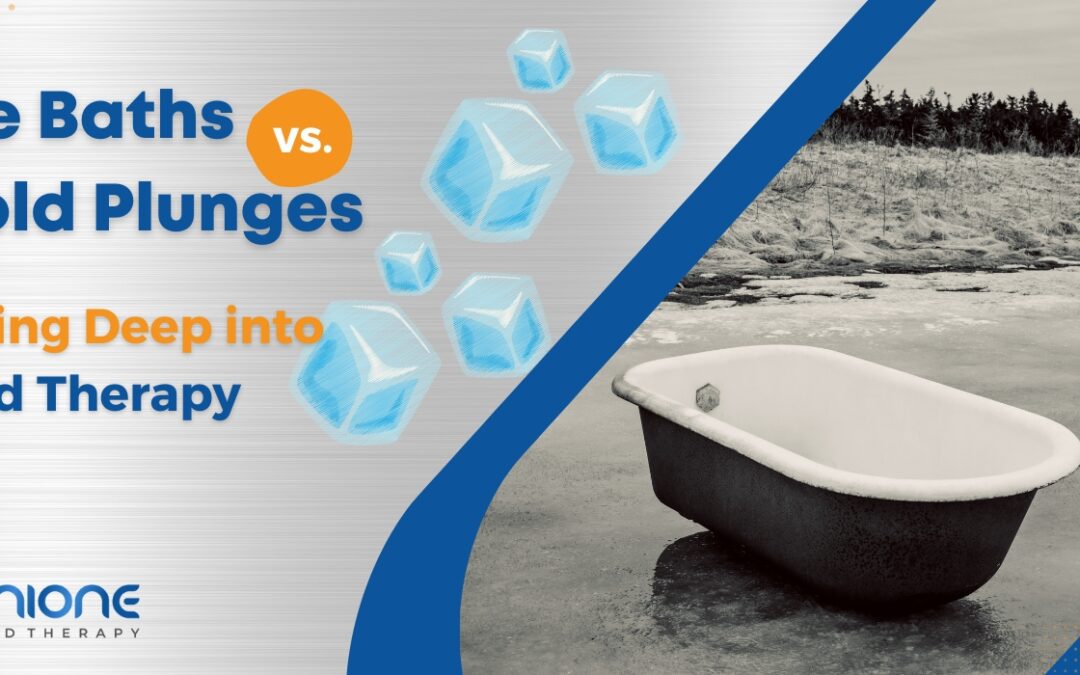

Cold therapy, a practice deeply rooted in human history, has seen a resurgence in recent years, driven by both elite athletes and health enthusiasts alike. Among the popular modalities of cold therapy are the iconic ice bath and the increasingly prevalent cold plunge. But what exactly differentiates these two? And what do they have in common? If you’re looking to dive into the frosty world of cold therapy, this article will break the ice!
1. What are they?
Ice Baths: The ice bath, as the name suggests, is a bath filled with ice and water. Athletes and trainers commonly use them to alleviate muscle soreness after intense physical exertion.
Cold Plunges: A cold plunge, or cold plunge pool, is essentially a small, deep pool filled with chilled water. While its primary purpose is also for recovery, it’s designed for quick, immersive dunks rather than prolonged soaks.
2. Temperature Differences
Ice Baths: Temperatures typically range from 3 to 10°C. The ice in the bath ensures that the temperature remains consistently cold for the duration of the therapy.
Cold Plunges: Cold plunge pools are maintained at cooler temperatures, often between 1°C to 5°C). With the help of ice bath chillers, the temperature remains consistent, eliminating the need to regularly add ice.
3. Duration of Use
Ice Baths: Users typically remain in ice baths for 3-10 minutes. The time can vary depending on individual tolerance and the specific recovery needs.
Cold Plunges: Cold plunges are designed for shorter durations – usually around 1-3 minutes. The idea is to immerse quickly, experience the therapeutic shock, and then exit.
4. Benefits
Both ice baths and cold plunges offer numerous benefits:
Muscle Recovery: The cold temperatures help reduce muscle inflammation and soreness post-exercise.
Improved Circulation: The cold immersion causes blood vessels to constrict and then dilate upon exiting, boosting circulation.
Enhanced Immune Response: Regular cold therapy can lead to an increase in white blood cells, improving the body’s immune response.
Mental Sharpness: The cold experience can heighten alertness and clarity of thought.
5. Equipment and Maintenance
Ice Baths: An ice bath can be as simple as a tub filled with water and ice. However, maintaining the desired temperature requires regular addition of ice. For a more controlled experience, many opt for ice bath chillers.
Cold Plunges: Cold plunge pools are equipped with chillers to maintain consistent temperatures. They require regular cleaning and maintenance to ensure water quality
Conclusion
Whether you’re leaning towards the crunchy embrace of an ice bath or the deep dive of a cold plunge, both options offer incredible benefits for body and mind. Whichever path you choose, the refreshing chill of cold therapy awaits.
If you’re interested in equipping yourself for the ultimate cold therapy experience, explore our range of ice baths and chillers, tailored to enhance your recovery journey. Dive in, and experience the chill!
The Icy Revolution: Why Ice Baths and Cooling Equipment Are the Ultimate Wellness Tools
August 10, 2023
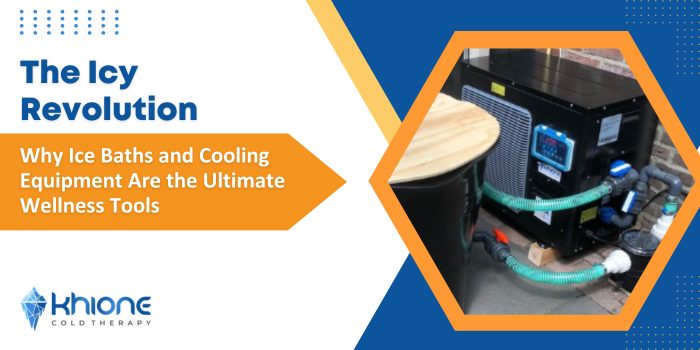

It’s no secret that health and wellness are trending more than ever. From plant-based diets to mindfulness apps, everyone is on a quest for optimal health. But have you ever considered the potential benefits of something as simple (yet profound) as cold therapy? It’s not just for athletes anymore. Welcome to the icy revolution brought to you by ice baths and an array of innovative cooling equipment like the CoolTub Ice Bath, CoolCube Ice Bath Cooler, and the CoolPillow cooled pillow.
Ice Baths: More than Just Cold Water
Though it might look like you’re merely stepping into an oversized ice cube, the benefits of an ice bath run deep.
- Muscle Recovery: Athletes swear by it. After a grueling training session, the cold temperature helps reduce inflammation, alleviate muscle soreness, and accelerate recovery.
- Boost Mental Fortitude: Overcoming the initial shock of cold water builds mental resilience and can translate to tackling everyday challenges with better composure.
- Improve Circulation: Cold water immersion boosts blood flow, ensuring that your cells receive the nutrients and oxygen they need.
And with the CoolTub Ice Bath, you’re not just getting a tub. You’re investing in a precise tool to control temperature and ensure the most beneficial immersion experience.
Keeping It Cool with the CoolCube
If you’re serious about your ice baths, maintaining the right temperature is crucial. The CoolCube Ice Bath Cooler is your reliable companion for this.
- Temperature Precision: With CoolCube, the guesswork is gone. Set the desired temperature and let it handle the rest.
- Efficiency: The equipment rapidly chills water, ensuring your bath is ready whenever you are.
- Safety: It’s built with high-grade materials that ensure a long-lasting, safe chilling experience.
Sleep Cold, Sleep Better with the CoolPillow
Ever flipped your pillow to feel the cooler side? What if you could maintain that cold, refreshing sensation throughout your slumber? Enter, the CoolPillow.
- Deep Sleep: A cooler head promotes better deep sleep cycles, enhancing overall sleep quality.
- Temperature Regulation: No more night sweats. The CoolPillow keeps you consistently cool, ensuring a comfortable sleep environment.
- Memory Foam Comfort: Cooling tech combined with memory foam? It’s the dream combo for a restful night.
Conclusion: Embrace the Chill
Cold therapy, once the realm of top-tier athletes, is now accessible and beneficial for everyone. With products like the CoolTub, CoolCube, and CoolPillow, you’re not just purchasing equipment; you’re investing in a lifestyle that promotes recovery, resilience, and relaxation. Dive into the icy revolution and discover the profound benefits for yourself.
Interested in getting started? Browse our range of ice baths and cooling equipment to kickstart your cold therapy journey.
How the Khione CoolPillow Can Help You Sleep Better
August 2, 2023
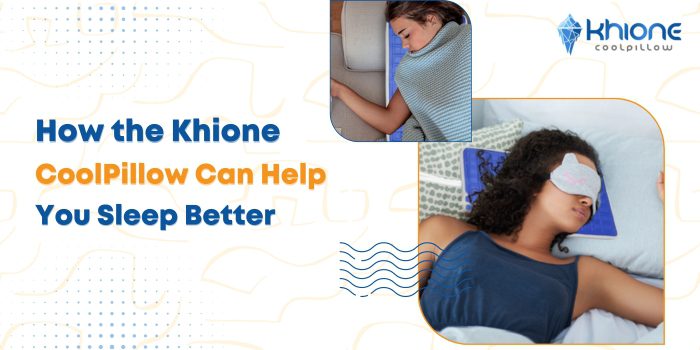

Sleep is essential for our health and well-being. However, many people find it difficult to sleep well, especially on hot nights. This is because our body temperature naturally decreases when we sleep, and if we get too hot, it can disrupt our sleep.
The Khione CoolPillow is a water-based cooling pillow that uses an innovative temperature control system to keep your head cool and comfortable all night long. The pillow is made with a soft, breathable fabric that wicks away moisture, and the cooling unit is whisper-quiet, so you won’t be disturbed by any noise.
The Khione CoolPillow can help you sleep better in a number of ways:
- It helps you sleep cooler. This is the most obvious benefit of the Khione CoolPillow. When you’re not too hot, you’re more likely to fall asleep and stay asleep.
- It reduces tossing and turning. When you’re hot, you tend to toss and turn more, which can disrupt your sleep. The Khione CoolPillow can help you stay cool and comfortable, so you’re less likely to toss and turn.
- It improves your sleep quality. When you sleep better, you’re more likely to feel refreshed and energized the next day. The Khione CoolPillow can help you get a better night’s sleep, so you can wake up feeling your best.
If you’re looking for a way to improve your sleep quality, the Khione CoolPillow is a great option. It’s comfortable, effective, and easy to use. Order yours today and start enjoying the benefits of a cooler, more comfortable sleep!
Here are some additional tips for getting a better night’s sleep:
- Create a relaxing bedtime routine.
- Make sure your bedroom is dark, quiet, and cool.
- Avoid caffeine and alcohol before bed.
- Get regular exercise, but not too close to bedtime.
- See a doctor if you have a sleep disorder.
With a little effort, you can get the sleep you need to feel your best. The Khione CoolPillow can help you get a better night’s sleep, so you can wake up feeling refreshed and energized.
The Ultimate Sleep Solution for Hot Nights
July 17, 2023
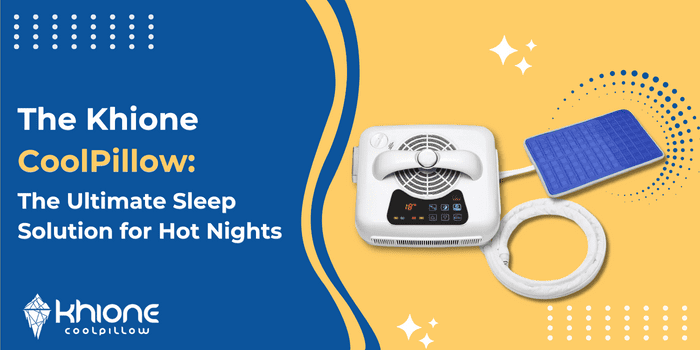

Do you toss and turn all night long, trying to find a cool spot to lay your head? If so, you’re not alone. Millions of people suffer from sleep problems caused by hot weather. But there is hope! The Khione CoolPillow is the ultimate sleep solution for hot nights.
The Khione CoolPillow is a water-based cooling pillow that uses an innovative temperature control system to keep your head cool and comfortable all night long. The pillow is made with a soft, breathable fabric that wicks away moisture, and the cooling unit is whisper-quiet, so you won’t be disturbed by any noise.
The Khione CoolPillow is easy to use. Simply plug it in, adjust the temperature to your desired level, and enjoy a cool, comfortable night’s sleep. The pillow is also adjustable, so you can customize it to your individual needs.
The Khione CoolPillow is the perfect solution for hot sleepers. It’s comfortable, effective, and easy to use. If you’re looking for a way to improve your sleep quality on hot nights, the Khione CoolPillow is the perfect choice for you.
Here are some of the benefits of using the Khione CoolPillow:
- Helps you sleep cooler and more comfortably on hot nights.
- Can help you reduce tossing and turning, which can lead to better sleep quality.
- Is easy to use and can be adjusted to your desired level of coolness.
- Is made with high-quality materials and is built to last.
- Is backed by a satisfaction warranty.
If you’re looking for a way to get a better night’s sleep on hot nights, the Khione CoolPillow is the perfect solution for you. Order yours today and start enjoying the benefits of a cooler, more comfortable sleep!
To learn more about the Khione CoolPillow, you can contact us.
Relieving Migraines Naturally with Cold Therapy
July 5, 2023


Human Nature has always found solace in the healing powers of nature. When it comes to treating migraines, cold therapy emerges as a natural and effective approach. With its ability to provide instant relief and minimal side effects, cold therapy offers a promising solution for those seeking a natural alternative to traditional medications. Let’s delve into the wonders of cold therapy and how it can help alleviate migraines.
What is Migraine?
Migraines are debilitating headaches often accompanied by symptoms such as nausea, sensitivity to light and sound, and throbbing pain. These episodes can significantly disrupt daily life and leave individuals desperate for relief. While over-the-counter painkillers and prescription medications exist, some people may prefer a more holistic approach that doesn’t rely on pharmaceutical interventions.
The Science Behind Cold Therapy:
Cold therapy, also known as cryotherapy, involves applying cold to specific areas of the body. The cold temperature constricts blood vessels, reducing blood flow and numbing the area, resulting in pain relief. When applied to the temples or the back of the neck during a migraine attack, cold therapy can help alleviate pain and minimize accompanying symptoms.
Natural Cold Therapy Techniques:
Cold Compress: Place a cold pack or a bag of frozen vegetables wrapped in a cloth on the affected area. Apply gentle pressure for 15-20 minutes to reduce inflammation and soothe the pain.
Cold Showers: Taking a cold shower can help decrease overall body temperature, easing the intensity of a migraine. Begin with warm water, then gradually reduce the temperature to a comfortably cold level.
Ice Pack Pillow / Cool Pillow: Fill a pillowcase with ice packs and rest your head on it during a migraine attack. This technique targets both the temples and the back of the neck simultaneously, providing comprehensive relief.
Benefits of Cold Therapy:
Embracing cold therapy for migraine relief offers numerous benefits. It’s a drug-free and non-invasive method that can be easily incorporated into one’s lifestyle. Unlike medications, cold therapy doesn’t carry the risk of potential side effects, making it a safe alternative for those seeking natural relief.
Nature has always provided us with remarkable remedies for various ailments, and cold therapy stands out as an effective natural solution for migraine sufferers. By harnessing the power of cold, we can tap into the body’s innate ability to heal and find relief from the grip of migraines. So, the next time a migraine strikes, consider embracing the chill of cold therapy and let nature work its magic on your path to wellness.
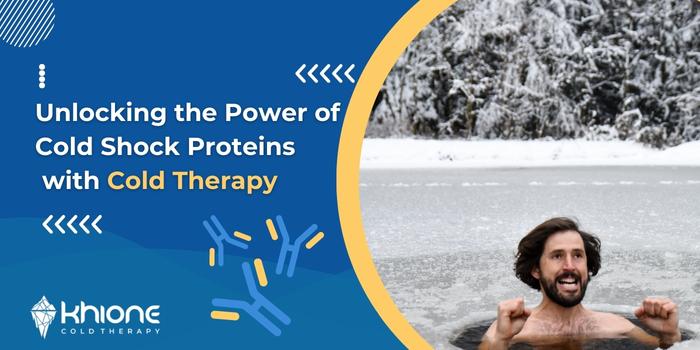

Cold shock proteins (CSPs) are proteins produced in response to cold stress, which help cells adapt to cold temperatures by protecting proteins from unfolding and maintaining cell membranes. CSPs work by binding to unfolded proteins, preventing aggregation and ensuring proper folding, which is crucial for cell function at cold temperatures. These conserved proteins are essential for the survival of cells and organisms in cold environments, acting as guardians, stabilizing cellular structures, regulating gene expression, and facilitating the repair of damaged molecules. CSPs are found in various organisms, including bacteria, archaea, plants, and animals, and are essential for the survival of cells and organisms in cold environments.
Activating Cold Shock Proteins:
Gradual Cold Exposure: Begin by gradually exposing yourself to colder temperatures. Start with shorter durations and gradually increase exposure time as your body adapts. This could include cold showers, ice baths, or spending time outdoors in chilly environments.
Cold Water Immersion: Take cold water baths or showers. Begin with lukewarm water and gradually decrease the temperature over time. Spend a few minutes in the cold water to allow your body to adapt and trigger the production of CSPs.
Cold Training Techniques: Explore methodologies like the Wim Hof Method, which combines specific breathing exercises with cold exposure. This technique can enhance the activation of CSPs and promote overall well-being.
Benefits of Cold Shock Proteins:
Activating cold shock proteins can have numerous potential benefits. Research suggests that they may enhance stress response, improve immune function, and promote overall resilience. However, it’s important to note that more research is needed to fully understand their mechanisms and applications.
Final Words:
Cold shock proteins represent an intriguing aspect of cellular biology, revealing the body’s remarkable adaptability to cold stress. By engaging in gradual cold exposure and utilizing techniques such as cold water immersion and cold training methods, we can potentially unlock the benefits of these proteins and bolster our cellular resilience.
Experience the revitalizing advantages of ice baths throughout the entire summer in the convenience of your own home with the Khione CoolCube. Explore the complete collection of ice bath cooling equipment at www.khione.store today, and ensure that this summer becomes your most refreshing one yet!
Improve Cognitive Function with Cold Therapy
June 9, 2023
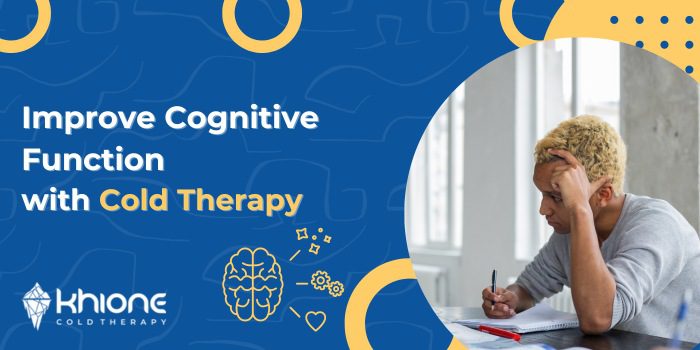

Have you ever wondered if there’s a simple yet effective way to sharpen your thinking, enhance your focus, and boost your overall cognitive function? Look no further than cold therapy! While it may sound surprising, subjecting your body to cold temperatures can have numerous benefits for your brain. In this blog post, we will explore the science behind cold therapy and its potential to improve cognitive function.
Cold therapy is a type of alternative medicine that uses exposure to cold temperatures to improve health and well-being. It has been shown to have a number of benefits, including reducing inflammation, improving circulation, and boosting the immune system.
In recent years, cold therapy has also been shown to have potential benefits for cognitive function. Studies have shown that cold exposure can increase brain activity, improve memory, and reduce stress.
One way that cold therapy may improve cognitive function is by increasing blood flow to the brain. When the body is exposed to cold, it releases hormones that cause the blood vessels to constrict. This increases blood pressure and forces more blood to flow to the vital organs, including the brain.
Cold exposure can also increase brain activity. Studies have shown that cold temperatures can increase the production of brain-derived neurotrophic factor (BDNF), a protein that helps to protect and repair neurons. BDNF is essential for learning and memory, and its levels tend to decline with age.
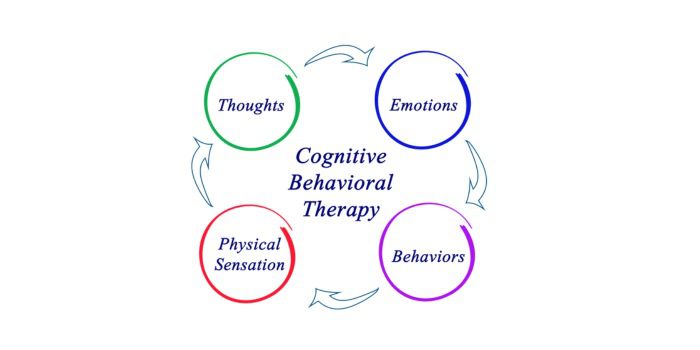
Cold Therapy and Cognitive Function:
Studies have revealed that cold therapy can also positively impact cognitive function. When exposed to cold temperatures, our body releases endorphins and activates the sympathetic nervous system, which increases blood circulation and oxygen delivery to the brain. This improved blood flow facilitates the supply of essential nutrients and removes metabolic waste, leading to enhanced brain function.
Memory and Focus Enhancement:
Cold therapy has been shown to enhance memory and cognitive performance. Cold exposure stimulates the production of norepinephrine, a neurotransmitter responsible for regulating attention and focus. This heightened level of norepinephrine helps improve concentration, memory retention, and overall mental acuity.
Mood Elevation and Stress Reduction:
Additionally, cold therapy has a positive impact on mood and stress reduction. Cold exposure triggers the release of endorphins, which are known as “feel-good” hormones. These endorphins promote relaxation, reduce anxiety, and elevate mood, all of which contribute to better cognitive function.
Incorporating Cold Therapy Into Your Routine:
To experience the cognitive benefits of cold therapy, start by gradually introducing cold showers or ice baths into your daily routine. Begin with shorter durations and slowly increase the exposure time as your body becomes accustomed to the cold. Alternatively, you can explore cryotherapy chambers available in specific wellness centres.
Conclusion:
Improving your cognitive function doesn’t have to be complicated. Cold therapy provides a simple and effective way to boost your brainpower. By incorporating cold showers or ice baths into your routine, you can enhance memory, focus, and overall cognitive performance. So, embrace the power of the cold and unlock your brain’s full potential! If you want to start cold therapy then experience the transformative power of cold therapy with CoolCube. Try our powerful water chiller today and unlock the full potential of your cold therapy journey.



